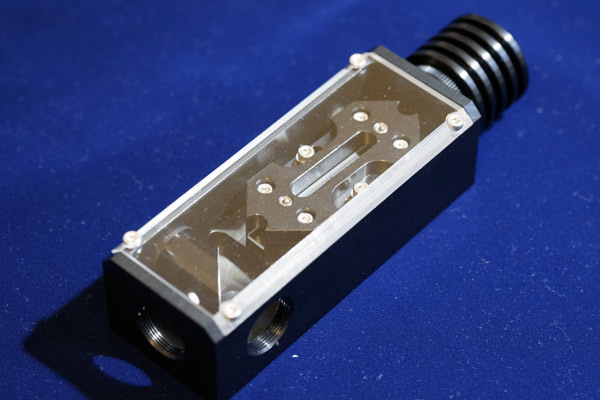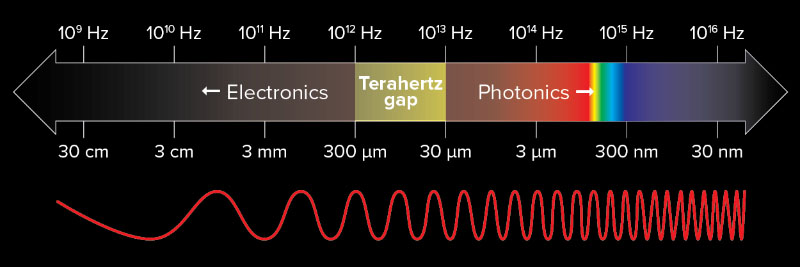| Jul 06, 2023 |
Making waves with terahertz technologies
(Nanowerk News) Countless technologies – from smartphones and TVs to infrared instruments on the James Webb Space Telescope and high-speed wireless telecommunication devices using microwaves – exploit sections of the electromagnetic spectrum.
|
|
But somewhere between commonly used microwaves and infrared light, lies a neglected region called the terahertz band. Terahertz waves have numerous exciting potential uses, not least because they can be used to see through or inside materials in a similar way to x-rays. Unlike x-rays, however, terahertz waves don’t deliver damaging ionizing radiation.
|
|
But terahertz technologies have so far languished because it has been difficult to adapt microwave- or visible-light technologies to the terahertz range at useful sizes and power outputs.
|
|
For example, one approach to generate terahertz waves has been to develop electrical devices that produce higher frequency, ultrashort-wavelength microwaves. But this has been difficult in part because these devices need highly optimized parameters to produce greater electrical performance, which has proved challenging.
|
|
An alternative strategy is to produce terahertz waves by converting shorter, higher-frequency waves of infrared light, using materials known as nonlinear crystals.
|
|
At the RIKEN Center for Advanced Photonics, we are exploring this second strategy—producing terahertz waves by converting the output from an infrared laser. This method has traditionally required enormous lasers to generate terahertz waves powerful enough for most practical applications. But this has limited the take-up of terahertz technology for real-world applications – where portable devices for in situ analysis would be far more valuable.
|
|
In the Tera-Photonics Research Team, which I lead, we hope to develop palm-sized, powerful terahertz wave sources for applications in industry and fundamental research. We have recently taken huge strides toward this goal and have multiple industrial collaborations underway.
|
 |
| A device created by Hiroaki Minamide and his team, which efficiently converts infrared radiation into terahertz waves. It can generate terahertz radiation over the entire range of the terahertz band. (Image: RIKEN)
|
Palm-sized devices
|
|
We have focused on using lithium niobate, a nonlinear crystal that produces a beam of terahertz waves when irradiated with near-infrared laser light. When I assumed leadership of the team in 2010, it was impossible to produce sufficiently powerful terahertz waves using this method, despite many years of work.
|
|
In 2011, we had to stop lab research for several months after a major earthquake struck Sendai, Japan, where our campus is. During that period, I remembered the result of a previous experiment that had caught my attention, and, I found an exciting hint of a possible path forward.
|
|
At that time, we used a near-infrared laser with pulse durations in the nanoseconds. The results indicated that when shorter, sub-nanosecond laser pulses were used, terahertz-wave generation as a function of the input laser pulse was altered. I wondered why this was.
|
|
I then uncovered a 1993 paper (Faris, G. W., Jusinski, L. E. & Hickman, A. P. J. Opt. Soc. Am. 8, 87–99 (1993)) that reported the effects of laser pulse duration in nonlinear crystals. The study—analyzing visible light—implied that using shorter pulses reduced a light-scattering effect called Brillouin scattering. I wondered whether, by reducing our laser pulse duration, we could minimize Brillouin scattering from our lithium niobate crystals. This might allow us to convert more of the laser light into terahertz waves and increase the power output.
|
|
Once we returned to the lab and tested this theory, we were amazed by the result. Using sub-nanosecond laser pulses, we could escape Brillouin scattering to improve our terahertz wave power output by six orders of magnitude—from 200 milliwatts to 100 kilowatts (Minamide, H. et al. J. Infrared, Millimeter, and Terahertz Waves 35, 25 (2014)). We finally had powerful emission from a device only one meter square, much smaller than previous terahertz apparatuses, which filled entire rooms. But when we showed this device to industry, they told us that it was still too big for real-world applications.
|
|
To further miniaturize our terahertz-wave source, we replaced the bulk lithium niobate crystal ingot we had previously used with a thin lithium niobate crystal with an artificial polarization-modulated microstructure, which is called a periodically poled lithium niobate (PPLN) crystal. Commonly employed in the visible-light region, the PPLN crystal enabled us to develop a handheld device due to its higher light conversion efficiency.
|
|
At the beginning of our PPLN research, there was no known way to efficiently generate terahertz waves using PPLN crystals. As we proceeded with our own experiments, we were initially very puzzled by the behavior of PPLN crystals. We saw no terahertz waves, just an unexpected light beam, produced from the crystal.
|
|
After carefully analyzing the properties of this light, we eventually realized that terahertz waves were being produced, but in an unexpected direction. The interaction between the light and the PPLN’s polarization-modulated structure caused terahertz waves to be generated at the rear of the crystal. When we moved our detector behind it, we found the terahertz wave (Nawata, K. et al. Sci Rep-UK 9, 726 (2019)). We could finally make a palm-sized prototype with a high conversion efficiency and sufficient power.
|
|
Remarkably, we also discovered that simply by rotating the crystal, we could tune the frequency of the terahertz waves produced (Minamide, H. et al. in 2021 Conference on Lasers and Electro-Optics (CLEO) (IEEE, 2021)). Our devices can completely cover the critical sub-terahertz region of the spectrum, which is especially important for non-destructive imaging applications.
|
 |
| Sandwiched between microwaves and infrared radiation on the electromagnetic spectrum, the terahertz gap has been underutilized in technologies until now. Like x-rays, terahertz waves have the ability to see through materials. But because terahertz waves have much lower frequencies (and hence energies) than x-rays, they do not pose the same risk to health that ionizing radiation does. (Image: RIKEN)
|
Quantum leap
|
|
Our research is based on photon conversion between light waves and terahertz waves by nonlinear optical effects based on mature photonic and laser technologies. We’ve achieved cascade oscillation in backward terahertz-wave parametric oscillation by using optical injection to lower the threshold and stabilize the output power—achieving a peak terahertz output power of 200 watts at a frequency of 0.3 terahertz; converted terahertz waves to light waves in a backward optical quantum conversion process; and succeeded in detecting ultraweak terahertz waves of approximately 50 attojoules, which is 1,000 times more sensitive than a 4 kelvin bolometer.
|
|
These results provide new quantum research based on terahertz-to-light quantum photon conversion. Our most recent results are based on incorporating quantum theory into our work. And our future work will explore quantum entanglement – where one quantum particle mysteriously mirrors another far away – to improve the sensitivity of terahertz detectors.
|
|
Furthermore, our highly miniaturized, high-power terahertz waves systems are complemented by recent developments in compact, powerful photonic lasers. Our devices use a new microchip laser that produces far-infrared laser pulses at sub-nanosecond speeds and high powers.
|
|
We’re now at the point where industrial collaborations form a key part of our work. The strong sub-terahertz emissions that our devices can generate are highly suited to imaging and analytical work. We’re conducting joint research with Japanese companies specializing in electronics, optical and photonics – such as Ricoh, Topcon, Mitsubishi Electric and Hamamatsu Photonics – to develop non-destructive testing applications and terahertz-wave spectroscopy equipment.
|
|
To demonstrate the potential of our technology for security purposes, we have assembled a prototype terahertz imaging device. With it we showed that a plastic gun, which can fire plastic bullets, could be clearly detected when concealed behind bumpy glass that scatters light a lot. We could also clearly image a pair of scissors hidden in a thick leather bag.
|
|
Terahertz waves can also reveal the chemical composition of substances, due to characteristic ‘fingerprint’ absorption patterns. Different colorless liquids—such as kerosene and acetone—that look identical to the naked eye can be readily identified by this method, for example. Thus, applications under consideration for terahertz waves range from airport security scanners to the analysis of historic artworks.
|
|
Industrial paint and outer coatings can also be analyzed, from things as varied as new cars and pharmaceutical tablets—and non-destructively, unlike current methods. In the future, we could mount our devices onto robots to crawl along industrial pipework to inspect for corrosion or on drones to inspect paint on power transmission towers.
|
|
These and other uses could give us a better understanding of how materials interact and degrade in situ. If we can better understand these issues using non-destructive technologies, we can more easily tweak production processes in real time to improve efficiencies and make patches to extend the life span of structures, for example. The economic and environmental benefits should be exponential.
|


